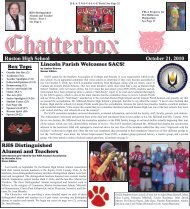December 2011 Chatterbox - Ruston High School
December 2011 Chatterbox - Ruston High School
December 2011 Chatterbox - Ruston High School
Create successful ePaper yourself
Turn your PDF publications into a flip-book with our unique Google optimized e-Paper software.
E<br />
ditorials/Opinions <strong>Chatterbox</strong><br />
<strong>Ruston</strong> <strong>High</strong> <strong>School</strong> <strong>December</strong> 15, <strong>2011</strong> Page 14<br />
The Joy of Santa Claus<br />
by Elena Till<br />
Assistant News Editor<br />
Santa Claus dates back to Saint Nicholas of Myra from the fourth century and the modern Santa is derived from the Dutch figure<br />
called Sinterklaas. He is a legendary figure that has been the popular bringer of gifts for many years. Every Christmas season, children<br />
write a letter to Santa telling him what they want for Christmas and on Christmas Eve, traditionally, a glass of milk and a plate of cookies<br />
are left for Santa as an expression of gratitude for the gifts. However, some parents do not wish to let their children believe in Santa<br />
Claus.<br />
As a young child, I remember looking forward to every Christmas; I would get so excited about writing my letter and placing<br />
it on the mantel; I would anxiously wait for morning to ensure that it was taken by Santa to the North Pole. It was my strong belief that<br />
Santa really did deliver presents to my house on Christmas night. As years passed and I grew older, it became obviously clear that my<br />
parents were ―Santa Claus.‖ This was not a huge disappointment to me but, rather, it was a little sad as I came to the conclusion that my<br />
childhood was coming to an end. I am grateful to my parents for giving me that joy as a child. Having something to look forward to<br />
every Christmas was extremely fun and children who do not get to experience the Santa Claus process are missing out on a wonderful<br />
joy. Whenever I have children of my own, they will definitely be writing to Santa Claus every evening.<br />
Are We Slaves of Our Own Mind?<br />
by Thristan Cecil<br />
Clubs Reporter<br />
Addictions<br />
What, how, and why?<br />
by Sarah Kay Blaylock<br />
Arts Reporter<br />
As we grow up, we finally come to our adolescent years, a very bumpy part of our lives. At this age, we adolescents are constantly<br />
changing, growing, and learning about our own lives at hand. We start becoming more aware of our mistakes and take responsibility<br />
which, in the end, shapes our future. Physically and mentally, our bodies grow and become more adult like. We strive for more individuality<br />
and freedom, and we look for more social acceptance in our lives with our fellow peers.<br />
Adolescents tend to be selfish, un cognitive, lacking in self motivation, lacking in self security, curious, shallow, and open to a wide<br />
variety of subjects, such as risky behavior. However, recent scientific studies have found an explanation for teens‘ teen-ish behavior.<br />
Research indicates that our brain activity is low, at this age, and is still undergoing a course of maturity. The adolescent reward center in<br />
the brain is not as responsive to that of an adult. It is one thing for us to understand that the teenage brain is different, but it is our job to<br />
distinguish our choices, make the right ones, and prevent/ ease conflicts within our younger years.<br />
―I am addicted to Icees. I get one every day after practice or before school and I even know which stores have better prices on<br />
them. I am not interested in cutting back on Icees because I feel really sad and incomplete without them. If, eventually, one Icee a day<br />
turns into more than one Icee a day, like 5 Icees each day, it does not concern me. The more, the merrier!‖ -Emily Hearne, Junior.<br />
Though peoples‘ strange addictions are not always very serious or life damaging, they are still existent everywhere!<br />
One common and strange addiction that haunts the younger generation is ―Tanorexia‖. Yes, I just said that. If one has no clue what<br />
I mean when I say Tanorexic, I am referring to tanning addictions in our blossoming society. One looks into a mirror and to themselves,<br />
they do not feel tan enough. Found in sunlight and tanning beds is ultraviolet light (made up of UVA and UVB rays) that generate<br />
endorphins. Endorphins are chemicals, in the brain, that create a feeling of euphoria or extreme happiness. According to these<br />
latest studies, Tanning provides a certain rush, just as drugs or alcoholic beverages provide, which is why most girls and guys that<br />
have gone to tanning booths will not ever again settle for the tan in a can. (which are much more safe, trust me.)<br />
On a more serious note, some people are addicted to eating dirt. There is no one, that I am aware of, that likes eating dirt at <strong>Ruston</strong><br />
<strong>High</strong> <strong>School</strong>, so hopefully this does not pertain to our school body! However, if you are reading this article right now and you do prefor<br />
a little bit of, um, grime every now and then; I can tell you exactly why one tends to crave something so..dirty? A really long time<br />
ago, before Pop tarts and macaroni, stood earth herself. Do not misconstrue what I am saying, because studies do show that humans used to eat things such as: dirt, sticks,<br />
and even rocks! However, as the world has truly modernized, eating stuff, like my previous examples, is now considered pathological consumptions! Back then, Mr. and<br />
Mrs. Cave people totally dug themselves some dirt. Times have obviously changed and not everyone has completely converted to eating only processed foods and fresh<br />
produce. That is my theory!
















